Clinton Avenue
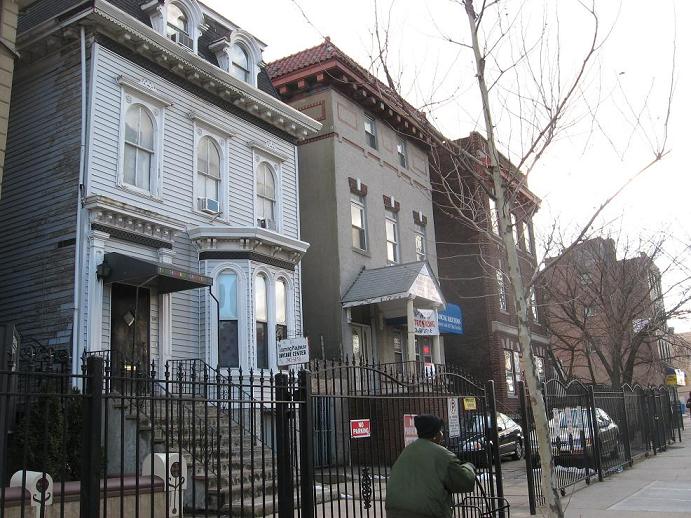
Clinton Avenue begins at Lincoln Park, once one of Newark's Silk Stocking districts. In the old days, elegant townhouses like these ones lined the beginning of Clinton Avenue. Louis Aronson of the Ronson Lighter Company lived at #86.
The Divine Riviera Hotel was built in 1922 and became a Newark residence for businessmen and legal figures doing business with the county and city. In the 1920s, the Riviera Hotel and its environs were so fine that Philip Roth's parents chose it for their "honeymoon." Longy Zwillman used the Riviera as his Third Ward residence in the 1930s.
The Riviera never recovered from the Great Depression. In 1949 it was sold to George Baker - aka "Father Divine," - who added the "Divine" to the name. Father Divine bought the 250 room hotel for cash! It took 14 bank tellers three and a half hours to count all the $1s, $5s, $10s, and $20s.
For the next few years the Divine Hotel Riviera was run as one of Father Divine's "Heavens." There was no alcohol sold and men and women had to be lodged separately.


One landmark of lower Clinton Avnue is the Roberto Clemente Shalom Towers. This unusually named apartment building was built on the site of the Manischewitz factory.
This apartment building was constructed under a program modelled on New York's Mitchell-Lama program. The sponsoring agency of the "Shalom Tower" was Jewish, but Puerto Ricans, who were a majority of the neighborhood at the time, objected to not being recognized in the apartment's name, hence the double named "Roberto Clemente-Shalom Towers."

Bergen Street Detour
This building at 730 Bergen Street isn't much to look at, nor do I suspect that it is very old, but it is one of the only physical remnants of the Newark Community Organizing Project, a spinoff from the SDS.
Beginning in the summer of 1964, young activists from outside Newark came to the city in hope of fostering a social-political movement that would demand political power for Newark's growing black population and full-employment. The most famous organizer would be Tom Hayden, then a recent University of Michigan grad.
The organizers chose Clinton Hill because it had then a mixed population. They also looked at the East Ward, but Clinton Hill was deemed superior because it had an existing neighborhood group called the "Clinton Hill Neighborhood Council" with which the organizers could work.
As organizers, the activists discovered that the whites and blacks in Clinton Hill did not share an agenda and that City Hall was impervious to criticism. The activists' victories were small ones, such as getting space for color guard girls to have space to practice. Civil rights for blacks and full employment eluded the idealists.
Most of the organizers went home or back to college after that first summer in 1964, but Tom Hayden stayed in Newark until 1968. Though he might have been an outside agitator, he was a committed one. Almost immediately after the riots, Hayden wrote an article pointing out how awful the Addonizio administration was and how most of the killings were committed by the police. Hayden would later write an informative and polemical take on the riots, "Rebellion in Newark: Official Violence and Ghetto Response."
730 Bergen Street was the first apartment the SDS group lived in. Their office was at 716 Bergen Street, but that is now just a vacant lot.
This abandoned landmark is the Clinton Trust Company, one of several banks that used to exist on this stretch of Clinton Avenue.
I have been able to find out little about the Clinton Trust Company, but the building is representative of bank architecture before the FDIC was created. By erecting such solid, grand buildings banks could display to depositors their solidity.
One reason the section of Clinton Avenue above Bergen Street is in such terrible shape is that there were riots here, centered on the Bergen Clinton intersection, in 1968. The 1968 riots were not as bloody as the 1967 riots, but they took a heavy toll in property damage.
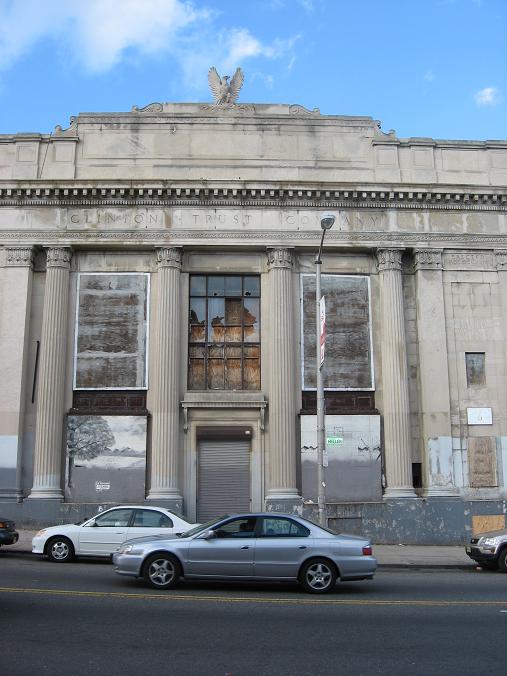


The former Robert Treat Savings Bank, now a church. Notice the relief of Robert Treat carved on the wall.

This is one of the few remaining temples of the Moorish Science, an independent quasi-Muslim group that was popular among African-Americans in the second quarter of the Twentieth century.
The Moorish Science Temple was founded in central Newark by Timothy Drew/Noble Drew Ali as the Canaanite Temple in 1913. "Moorish Science" is certainly not the Islam that is predominates from Morocco to Malaysia, but a mixture of Indian beliefs, the occult, Freemasonry, and Christianity. Instead of the Qu'ran of Muhammad which is familiar to all, the Moorish Science Temple has its own Qu'ran, called the "Holy Koran of the Moorish Science Temple of America," often called the "Circle Seven Koran." The first nineteen chapters are borrowed from the Aquarian Gospel, the latter 24 chapters are a Rosicrucian text.
Notice the Circle Seven in the upper right hand corner of the sign.
Noble Drew Ali preached that blacks were the descendents of the Moors, indeed, he urged his followers to call themselves "Moorish-Americans and avoid use designations like "black," "Negro," or "Colored." If other American minorities were known by their national origins, Ali said that blacks should be known by their origins as well, even if few blacks believed their ancestors were from what is now Morocco.
Noble Drew Ali preached race pride, but he was not a black separatist and never asserted that whites were evil, as Fard Muhammad and Elijah Muhammad did.
As can be seen by the Circle Seven Qu'ran, Noble Drew Ali had very little access to Islamic thought. Moorish Science servies resembled Christian services, with some elements of Masonic ritual, more than they resembled Islamic services. Moorish Americans pray in chairs, and not on prayer rugs. Men and women sit separately, but neither sex sits behind the other. Everyone wears fezzes.
The Moorish Science Temple was superseded by Wallace Fard Muhammad and Elijah Muhammad's Nation of Islam (which itself has many differences between it and mainstream Islam), but there are still a few Moorish Science temples around today.
Newark's other contribution to the development of Islam among African-Americans in America is a negative one. The assassins of Malcolm X were from Newark. The assassins had nothing to do with the Moorish Science Temple.


The City of Newark has tried to add some identity and pride to Clinton Hill with these flags.
The upper, western part of Clinton Avenue goes through a neighborhood usually called Clinton Hill. Clinton Hill was somewhat more affluent than the rest of the Clinton Avenue corridor. In the mid-Twentieth century, Clinton Hill was Newark's second largest Jewish community, after Weequahic.
The great monument of Clinton Hill's Jewish days was B'nai Abraham.
Along with Oheb Shalom and B'nai Jeshurun, Temple B'nai Abraham was one of the three oldest and three largest synagogues in Newark. B'nai Abraham, like Oheb Shalom, was a spin off from B'nai Jeshurun. The founders of B'nai Abraham objecting to B'nai Jeshurun's growing reform orientation.
Originally located downtown and then on High Street, B'nai Abraham was the last of the Big Three to build a grandiose synagogue, as Oheb Shalom and B'nai Jeshurun had built their grand synagogues on High Street in the 1910s.
Supported by the donations of thousands of congregants, including Louis Aronson of the Ronson Lighter Company, B'nai Abraham built this splendid edifice in 1924-1925. The architect was Nathan Myers and the cost was $600,000, paid in full by the synagogue, with no mortgage.


B'nai Abraham flourished in Newark for many years. Its rabbi from the 1930s to the 1970s was the famous Joachim Prinz. Prinz, a refugee from Nazi Germany, was one the nation's leading liberal rabbis throughout this period. Due to his experience under the Nazis, Prinz's devotion to Civil Rights was passionate and uncompromising. In 1963 Rabbi Prinz gave an address "I Speak as an American Jew" just before Martin Luther King gave his "I Have a Dream" speech at the March on Washington. In that same year B'nai Abraham was even honored with a visit from Rev. Martin Luther King himself.
By the late 1960s, as Prinz looked out at an empty synagogue on Friday night services, his faith in integration did waver at the practicality of integration. (a sentiment shared by the large majority of whites).
Nonetheless, B'nai Abraham did stay in Newark later than Oheb Shalom or B'nai Jeshurun. According to an unconfirmed story I was told, Rabbi Prinz did not favor moving to the suburbs until he was mugged in his office.
We associate middle-class living today with a single family detached house, but before World War II, middle-class families could and did live in apartment buildings like this one. 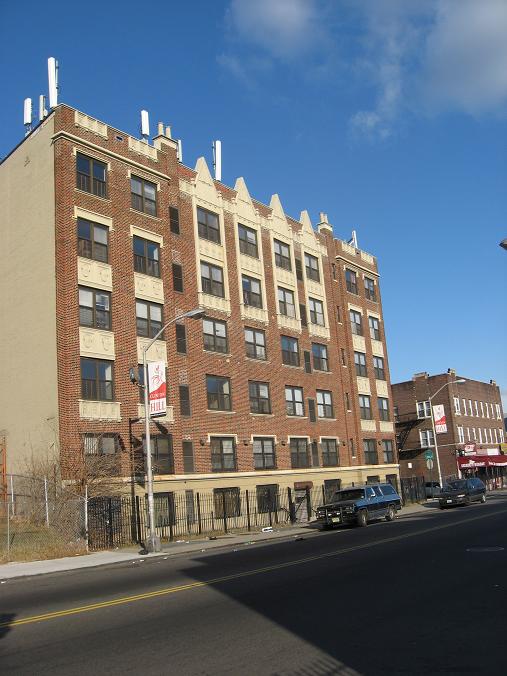

Across the street from B'nai Abraham is the Blessed Sacrament Church. The Blessed Sacrament Parish was established in 1902, with the present church building begun on Palm Sunday 1912.
Blessed Sacrament merged with St. Charles Borromeo church in Weequahic in 1999. St. Charles Borromeo, which occupied an attractive Art-Deco building, was the Catholic presence in Weequahic for almost ninety years.
Blessed Sacrament Church is a church proud of its diversity. On its wall is a statue of one of the first saints to live in the Americas.
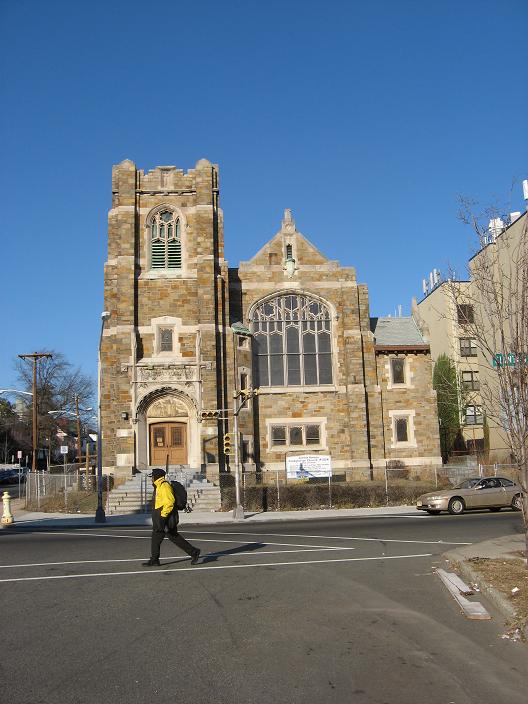

Clinton Hill was not as Jewish as Weequahic was though. This lunette at the Second Presbyterian Church shows that Newark had some Calvinist heritage too.
Girard Place Detour
Clinton Hill did have its share of single-family detached housing though. This is Girard Place, just south of Clinton Avenue.
From what I have read, Girard Place has long been a wealthy enclave.

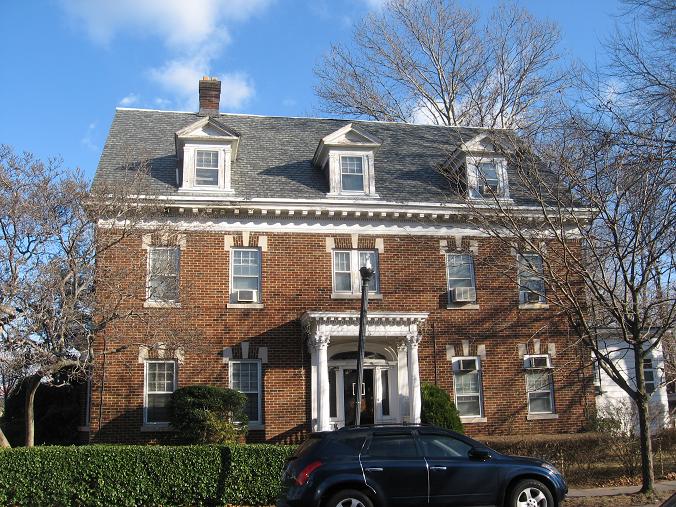
One of Girard Place's many fine homes.
Clinton Hill was badly hurt in the riots, but commerce is slowly coming back. This is a pretty nice Clinton Hill diner. I recommend the grilled cheese. 
February/March 2007.

![]()

I have just finished reading your history of the Clinton Hill section, and was delighted to find a picture of the house I grew up in just above the Clinton Hill banner. I have been back, as recently as this past September, and am always saddened at the changes. Our house has survived in pretty good shape. My father had his medical office in the house for about forty years. I found your site as I was searching for a history of the Clinton Trust Company, as my great grandfather and a great uncle were among the founders of the bank. When I saw the buiding in it's present condition in September I was dismayed. It was a beautiful bank building, with interior just as beautiful. I wonder what the marble, etc. inside looks like now?
ReplyDeleteThank you for bringing back memories and filling in gaps.
A former Clinton Hill resident